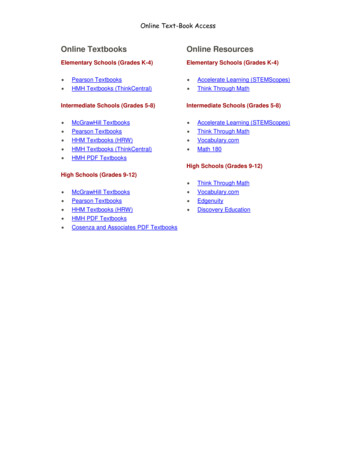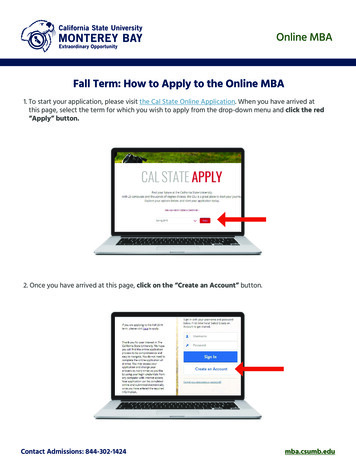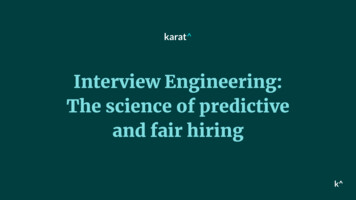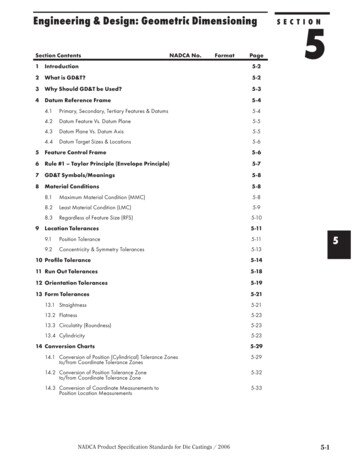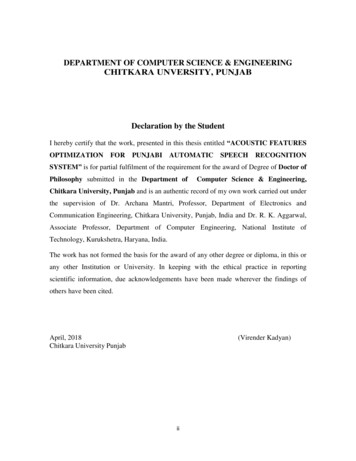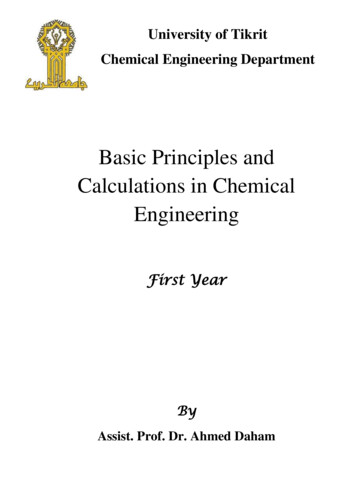
Transcription
NAL COUNCIL OF EXAMINERS FOR ENGINEERING AND SURVEYING NCEES.ORG/EXAMS
This document is copyrighted by NCEES and must be reproducedor distributed in accordance with NCEES guidelines.Contact permissions@ncees.org for more information. September 2014, All rights reserved.National Council of Examiners for Engineering and Surveying
FUNDAMENTALS OF ENGINEERINGSAMPLEQUESTIONS
Only one thing is betterthan being an engineer.Being a P.E.Clean water. Sound structures. Safe power. We are charged with preserving theseand many more fundamentals that protect the health, safety, and welfare ofthe public. Earn your license, and join the national community of professionalscommitted to excellence.YOUR BOARD SETS THE BAREngineering licensure in the United States is regulated by licensing boards in eachstate and territory. These boards set and maintain the standards that protectthe public they serve. As a result, licensing requirements and procedures varyby jurisdiction, so stay in touch with your board (ncees.org/licensing-boards).NCEESNCEES is a national nonprofit organization made up of the U.S. engineering andsurveying licensing boards in all 50 states, U.S. territories, and the District ofColumbia. It develops and scores the exams used for engineering and surveyinglicensure in the United States. It also promotes professional mobility through itsservices for licensees and its member boards.
Licensure: what it takesThese are the general requirements for licensure in the United States.Check with your licensing board for details specific to your jurisdiction.EDUCATIONEarn your 4-year bachelor of science degree.Make sure that your engineering program is EAC/ABET accredited.EXAMINATIONSPass the FE exam.Take the FE exam right before or after you graduate. It is administered year-roundat approved Pearson VUE test centers throughout the United States, the Districtof Columbia, and U.S. territories. Registration is always open, so plan ahead.Visit ncees.org/exams to review your state board’s policies and procedures.Pass the exam, and become an E.I. (engineer intern) or E.I.T. (engineer-in-training).Pass the PE exam.This exam is offered in April and October, though some disciplines are offered onlyannually. Registration opens 3–4 months ahead and closes 4–6 weeks before theexam date. Some state licensing boards require you to gain experience before youcan take the PE exam. Access your state licensing board’s policies and proceduresat ncees.org/exams.EXPERIENCEGet 4 years of engineering experience.This means progressive, acceptable, and verifiable work in the industry.Some boards require your supervisors to be professional engineers.
Take the first step.Take the FE.The Fundamentals of Engineering, or FE, exam is the first exam required for licensureas a P.E. (professional engineer). You’ll choose one of 7 freestanding, discipline-specificexams: Chemical IndustrialCivil MechanicalElectrical and Computer Other DisciplinesEnvironmentalIf you’re not sure which exam discipline to choose, look through FE Sample Questionsto help you decide. Each section contains the exam specifications, or subject areas,and 10 sample questions and solutions for each discipline.When you’re ready to take your exam, go to ncees.org/FE-exam to register.Once approved, you’ll schedule an appointment at an approved Pearson VUEtest center near you.
Add it together.Licensure sets you apart.Here’s how.RECOGNITION“P.E.” instantly says that you’re experienced, knowledgeable, and accountable.GROWTHEngineering positions at all levels of industry and government increasinglyrequire licensure.AUTHORITYAs a P.E., you can consult in private practice. Without it, you don’t have thesame opportunities.MOBILITYEarning your P.E. license in one state allows you to more easily apply for licensurein other states—a process known as comity licensure.MONEYSalary studies show that as a P.E., you can expect to earn significantly morethroughout your career.
FE EXAMQ&AWHAT’S THE FORMAT?Each exam contains 110 multiple-choice questions and is administered via computer atapproved Pearson VUE test centers. A 6-hour appointment time includes a tutorial, the exam,a break, and a survey. You’ll have 5 hours and 20 minutes to complete the actual exam.WHAT DOES THE EXAM COVER?The exam is designed for recent graduates and students who are close to finishing anundergraduate engineering degree. There are 7 freestanding, discipline-specific FE exams.The full exam specifications for each discipline are included in this book and are postedonline at ncees.org/FE-exam.WHAT CAN I TAKE INTO THE EXAM ROOM?The following items are allowed in the exam room: your ID, an NCEES-approved calculator, keyto your test center locker, reusable booklet provided by Pearson VUE, eyeglasses, light sweateror jacket, and items included in the Pearson VUE Comfort Aid List. An electronic version of theFE Reference Handbook is incorporated into the exam.HOW CAN I PREPARE?Purchase an NCEES FE computer-based practice exam, which provides the most realisticexam-day simulation available (ncees.org/PracticeExams).HOW DO I REGISTER?Log in to your MyNCEES account, select the REGISTER button, and follow the onscreeninstructions. If you need to create a MyNCEES account, go to account.ncees.org.HOW DO I SCHEDULE MY EXAM?Once your completed registration is approved, you’ll receive an email notification that you’reauthorized to take the exam and are eligible to schedule your exam appointment. To scheduleyour exam, log in to MyNCEES, select the SCHEDULE button, and follow the onscreeninstructions.WHERE AND WHEN CAN I TAKE THE EXAM?The FE is offered year round at approved Pearson VUE test centers.WHERE CAN I LEARN MORE?For more information, download the NCEES Examinee Guide or visit ncees.org/FE-exam.You can also go to youtube.com/NCEESMedia to watch short instructional videos that explainwhat to expect on exam day.
NCEES practice examsWe do the exams. You do the math.Study with NCEES.PURSUE EVERY ADVANTAGEWhy not study with NCEES? You’ll have the advantage of using a product that isdeveloped by the same people who create the exam that you are preparing to take.No other study materials can give you that.KNOW WHAT TO EXPECTNCEES practice exams are an excellent tool for helping you determine what youknow—and what you don’t know—before taking the exam. The computer-basedpractice exams Contain questions and solutions from past exams Simulate the real format, style, and level of difficulty Provide immediate feedback on performance in each topic areaFE COMPUTER-BASED PRACTICE EXAMSEvaluate your readiness for the FE exam by testing your knowledge with the mostrealistic computer-based simulation available. Each timed practice exam consistsof 50 questions and functions much the same as the actual exam. You will be given2.5 hours to complete your exam. Solutions to the questions will show you how toapproach problems, and immediate feedback about your performance in each topicarea can help you focus your preparation.
PURCHN.RAT IO10%NChemicalCivilElectrical and ComputerEnvironmentalIndustrialMechanicalOther DisciplinesSAVEW HE 49.95 eachSTChoose your discipline:ASEDW IT H E X A MREGIIf you purchase an FE computer-based practiceexam at the same time you register for an exam,you’ll receive a 10 percent discount on the practice exam.FE REFERENCE HANDBOOKReviewing the handbook before exam day will help you become familiar with thecharts, formulas, tables, and other reference information provided. Download thePDF and practice using it to help you navigate easily on exam day. Print Download 13.95FreeOrder at ncees.org/PracticeExams.PROVE YOURSELF WITHOUT SAYING A WORD.Standards matter. Character counts. Now more than ever, your P.E. can be thecompetitive edge you need.
TABLEOF CONTENTSDISCIPLINEChemical2Civil13Electrical and ther Disciplines63
CHEMICALFundamentals of Engineering (FE)CHEMICAL CBT Exam SpecificationsEffective Beginning with the January 2014 Examinations The FE exam is a computer-based test (CBT). It is closed book with an electronic reference.Examinees have 6 hours to complete the exam, which contains 110 multiple-choice questions.The 6-hour time also includes a tutorial, a break, and a brief survey at the conclusion.The FE exam uses both the International System of Units (SI) and the US Customary System (USCS).Knowledge2Number of Questions1.MathematicsA. Analytic geometryB. Roots of equationsC. CalculusD. Differential equations8–122.Probability and StatisticsA. Probability distributions (e.g., discrete, continuous, normal, binomial)B. Expected value (weighted average) in decision makingC. Hypothesis testingD. Measures of central tendencies and dispersions (e.g., mean, mode,standard deviation)E. Estimation for a single mean (e.g., point, confidence intervals)F. Regression and curve fitting4–63.Engineering SciencesA. Applications of vector analysis (e.g., statics)B. Basic dynamics (e.g., friction, force, mass, acceleration, momentum)C. Work, energy, and power (as applied to particles or rigid bodies)D. Electricity and current and voltage laws (e.g., charge, energy, current,voltage, power, Kirchhoff, Ohm)4–64.Computational ToolsA. Numerical methods and concepts (e.g., convergence, tolerance)B. Spreadsheets for chemical engineering calculationsC. Simulators4–65.Materials ScienceA. Chemical, electrical, mechanical, and physical properties(e.g., effect of temperature, pressure, stress, strain)B. Material types and compatibilities (e.g., engineered materials,ferrous and nonferrous metals)C. Corrosion mechanisms and control4–66.ChemistryA. Inorganic chemistry (e.g., molarity, normality, molality, acids, bases,redox reactions, valence, solubility product, pH, pK, electrochemistry,periodic table)B. Organic chemistry (e.g., nomenclature, structure, qualitative andquantitative analyses, balanced equations, reactions, synthesis, basicbiochemistry)8–12
Fluid Mechanics/DynamicsA. Fluid propertiesB. Dimensionless numbers (e.g., Reynolds number)C. Mechanical energy balance (e.g., pipes, valves, fittings, pressure losses acrosspacked beds, pipe networks)D. Bernoulli equation (hydrostatic pressure, velocity head)E. Laminar and turbulent flowF. Flow measurement (e.g., orifices, Venturi meters)G. Pumps, turbines, and compressorsH. Compressible flow and non-Newtonian fluids8–128.ThermodynamicsA. Thermodynamic properties (e.g. specific volume, internal energy, enthalpy,entropy, free energy)B. Properties data and phase diagrams (e.g. steam tables, psychrometric charts,T-s, P-h, x-y, T-x-y)C. Thermodynamic laws (e.g., 1st law, 2nd law)D. Thermodynamic processes (e.g., isothermal, adiabatic, isentropic)E. Cyclic processes and efficiency (e.g., power, refrigeration, heat pump)F. Phase equilibrium (e.g., fugacity, activity coefficient)G. Chemical equilibriumH. Heats of reaction and mixing8–129.Material/Energy BalancesA. Mass balance (steady and unsteady state)B. Energy balance (steady and unsteady state)C. Recycle/bypass processesD. Reactive systems (e.g., combustion)8–1210. Heat TransferA. Conductive heat transferB. Convective heat transfer (natural and forced)C. Radiation heat transferD. Heat transfer coefficients (e.g., overall, local, fouling)E. Heat transfer equipment, operation, and design (e.g., double pipe, shell andtube, fouling, number of transfer units, log-mean temperature difference,flow configuration)8–1211.8–12Mass Transfer and SeparationA. Molecular diffusion (e.g., steady and unsteady state, physical property estimation)B. Convective mass transfer (e.g., mass transfer coefficient, eddy diffusion)C. Separation systems (e.g., distillation, absorption, extraction, membrane processes)D. Equilibrium stage methods (e.g., graphical methods, McCabe-Thiele, efficiency)E. Continuous contact methods (e.g., number of transfer units, height equivalent to atheoretical plate, height of transfer unit, number of theoretical plates)F. Humidification and dryingCHEMICAL7.3
CHEMICAL412. Chemical Reaction EngineeringA. Reaction rates and orderB. Rate constant (e.g., Arrhenius function)C. Conversion, yield, and selectivityD. Type of reactions (e.g., series, parallel, forward, reverse, homogeneous,heterogeneous, catalysis, biocatalysis)E. Reactor types (e.g., batch, semibatch, continuous stirred tank, plug flow,gas phase, liquid phase)8–1213. Process Design and EconomicsA. Process flow diagrams and piping and instrumentation diagramsB. Equipment selection (e.g., sizing and scale-up)C. Cost estimationD. Comparison of economic alternatives (e.g., net present value,discounted cash flow, rate of return, expected value and risk)E. Process design and optimization (e.g., sustainability, efficiency,green engineering, inherently safer design, evaluation of specifications)8–1214. Process ControlA. Dynamics (e.g., time constants and 2nd order, underdamped, andtransfer functions)B. Control strategies (e.g., feedback, feed-forward, cascade, ratio, and PID)C. Control loop design and hardware (e.g., matching measured and manipulatedvariables, sensors, control valves, and conceptual process control)5–815. Safety, Health, and EnvironmentA. Hazardous properties of materials (e.g., corrosivity, flammability,toxicity, reactivity, handling and storage), including MSDSB. Industrial hygiene (e.g., noise, PPE, ergonomics)C. Process safety and hazard analysis [e.g., layer of protection analysis,hazard and operability studies (HazOps), fault-tree analysis or event tree]D. Overpressure and underpressure protection (e.g., relief, redundant control,intrinsically safe)E. Waste minimization, waste treatment, and regulation (e.g., air, water, solids,RCRA, CWA, EPA, OSHA)5–816. Ethics and Professional PracticeA. Codes of ethics (professional and technical societies)B. Agreements and contractsC. Ethical and legal considerationsD. Professional liabilityE. Public protection issues (e.g., licensing boards)2–3
2.3.CHEMICAL1.The only point of inflection on the curve representing the equation y x3 x2 – 3 is at:A.2x - 3B.1x - 3C.x 0D.1x 3Which of the following occurs in the reaction Cu 2 Zn Cu Zn 2?A.Only copper is oxidized.B.Only zinc is oxidized.C.Both copper and zinc are oxidized.D.Neither copper nor zinc is oxidized.The pressure of 100 kg of nitrogen (N2) at 70 C in a 100-m3 tank is most nearly:A.2,850 kPaB.102 kPaC.20 kPaD.102 mPa5
CHEMICAL4.Hydrogen (H2) and oxygen (O2) are reacted in a fuel cell to produce energy. The productof the reaction is water, and any excess gases are vented after the fuel cell, as shown inthe figure below. The hydrogen and oxygen tanks are maintained at the same temperatureand pressure, and they feed at the same volumetric flow rate. The reaction goes to 60%completion in the fuel cell (hydrogen basis).If all of the unreacted hydrogen and a portion of the unreacted oxygen are recycled, thenthe molar ratio of oxygen in the vent to oxygen in the fresh feed is most 0C.0.58D.0.82VENT
CHEMICAL5.The following figure is the solution of a binary distillation tower design using theMcCabe-Thiele method. The equilibrium curve shown is for Component A. Component Ais separated from B in the distillation column to produce a distillate that is 97 mole% A.The feed rate to the tower is 100 kmol/hr. The tower includes a partial reboiler and totalcondenser. The bottoms flow rate (kmol/hr) is most nearly:1.0980.87MOLE FRACTION A, VAPOR60.6540.4320.210.00.00.20.40.60.81.0MOLE FRACTION A, LIQUIDA.3.0B.42.6C.53.8D.97.07
CHEMICAL6.Operating conditions for a plug-flow reactor for the elementary liquid-phase reactionA B R are as follows:CAO 0.10 kmol/m3CB 0.10 kmol/m3V 0.50 m3q 0.20 m3/minCA (at exit) 0.40 kmol/m3The space time (min) for this reactor is most nearly:A.0.25B.0.40C.2.0D.2.57.If 500 is invested at an annual interest rate of 8% per year, its future worth at the end of30 years will be most nearly:8A. 1,200B. 1,700C. 5,031D. 15,000
9.CHEMICAL8.The volume (L) of 1 mol of H2O at 546 K and 1.00 atm pressure is most nearly:A.11.2B.14.9C.22.4D.44.8A chemical plant has a waste stream containing 5% by weight HCl flowing at the rate of1,000 L/min. Before it can be discharged, it must be neutralized with NaOH. A solutionof NaOH at a strength of 1% by weight is available. Molecular weights are as follows:NaCl 58.4HCl 36.5NaOH 39.9The specific gravity of the solutions may be assumed to be 1.0. The required flow rate(L/min) of the NaOH stream is most nearly:10.A.8,900B.5,500C.4,570D.220As a professional engineer originally licensed 30 years ago, you are asked to evaluatea newly developed computerized control system for a public transportation system.You may accept this project if:A.B.you are competent in the area of modern control systemsyou do not live in the jurisdiction where the transportation system is beinginstalledC.your original area of specialization was in transportation systemsD.you have regularly attended meetings of a professional engineering society9
CHEMICALSolutionsSolutions1.f(x) x3 x2 – 3Inflection point occurs when f "(x) 0Inflection point occurs when f "(x) 01.f(x) x3 2 x2 – 3f '(x) 3x 2xf '(x) 3x2 2xf "(x) 6x 2f "(x) 6x 2Set equal to zeroSet equal to zero6x 2 06x 2 0x –1/3x –1/3f "(x) is negative below x –1/3 and positive above x –1/3f "(x) is negative below x –1/3 and positive above x –1/3Since f "(x) 0 and f "(x) changes signs at x –1/3, the inflection point is at x –1/3.Since f "(x) 0 and f "(x) changes signs at x –1/3, the inflection point is at x –1/3.THE CORRECT ANSWER IS: BTHE CORRECT ANSWER IS: B2.2.Oxidation is defined as the loss of electrons. In this case, Cu 2 Cu, which gains two 2 Cu, which gains two electrons,Oxidationis defined 2 loss of electrons. In this case, Cuelectrons, andZn asZnthe, which loses two electrons. Therefore,only zinc is oxidized.and Zn Zn 2, which loses two electrons. Therefore, only zinc is oxidized.THE CORRECT ANSWER IS: BTHE CORRECT ANSWER IS: B3.3.Use the ideal gas formula:Use the ideal gas formula:PV mRTmRTP V8, 314 J kmolJR kmole·K 28 kg 297 kg·KP J(100 kg) b 297 kg·K l (343 K)100 m3 102, 000 J 3m 102, 000 N·mm3 102, 000 N2m 102 kPaTHE CORRECT ANSWER IS: B106
sSolutions1/2OO OBalancedBalancedequation:equation:HH 1/2 HHHOOBalancedequation: HPPOOOHandandVVHHH VVOOO and TTOTOOandFeedcharacteristics:sincePPHHHO 2 P andandTTTFeedcharacteristics:since2 1/22O VHHH2222222222 222 22 22Feed characteristics:sincePH PO and VH VO and TH law:2222Therefore, from ideal gas law:RTHH no nHo HHH PPHH VoVHo H no nHo H RTRatioRatioOO2 2 2 2 o o 2 2 2 2 2 2 no no 2 2 1.01.0no nOonoO2H2RTRTRT2H22 nOo OH2 22H2 22 PPPOHO222VV2H2 2 2 OO 1.0Ratio O PO2 Vo 2 no O2 RTO2 no ximumH2 nfeed,andat atmaximumH2 Hrecycle,all thewould22 2consumed:consumed:beconsumed:Usingbasis of 1 mole H2 in feed, and at maximum H2 recycle, all the hydrogen would beBalance HHH22OOBalanceequation:equation:HH2 22 1/2consumed:1/2OO222 2OBalance equation: H2 1/2 O2 H2OOO2 2OUT0.5molemole OUT 0.5 1.0Ratio0.5Ratio OO0.5mole1.0moleINO222IN0.5moleOUT 1.0 mole 0.5Ratio O2 INTHETHECORRECTCORRECTANSWERANSWERIS:IS:BBTHE CORRECT ANSWER IS: B5.5.5.5.6.6.6.FeedFeedbottomsdistillate100kg/hr bottoms distillate 100kg/hrFeed bottoms distillate 100kg/hr diagram, distillate ofFeed eononAAAgivesgivesBalanceA gives47000.04.on.044797 000.97 47 97DDD04BBB .47097D004sincesince100 100-DDsinceBBB 100-D B43sinceB 43100D43 -46thenthen 93 46D 46.2.22thenDD939343 100 4646.2 53then Dandand93- 100-46 53andBBB 10046.2.22 53.8.88and B 100 - 46.2 53.8THETHECORRECTCORRECTANSWERANSWERIS:IS:CCTHE CORRECT ANSWER IS: CTHE CORRECT ANSWER IS: CVV0.500.50mm3 3 2.5xx qq 2.5minmin3mm3 3/min0.20/minV 0.200.50m x q 2.5 minx 0.20 m3 /minTHETHECORRECTCORRECTANSWERANSWERIS:IS:DDTHE CORRECT ANSWER IS: D77711
CHEMICALSolutionsF7.012330500i 8%F 500(F/P, 8%, 30) 500 (10.0627) 5,031THE CORRECT ANSWER IS: C8.Pv nRT(1)(v) (1)(0.08206)(546)v 44.8 LTHE CORRECT ANSWER IS: D9.1, 0001.00 kg 5 kg HClkmol HClL L 100 kg36.5 kg HClmin F 1.00 kg 1kg NaOHkmol NaOHL 100 kg 39.9 kg NaOHF 5, 466 L/minTHE CORRECT ANSWER IS: B10.Refer to the NCEES Rules of Professional Conduct.THE CORRECT ANSWER IS: A12
Fundamentals of Engineering (FE)CIVIL CBT Exam SpecificationsEffective Beginning with the January 2014 Examinations KnowledgeCIVIL The FE exam is a computer-based test (CBT). It is closed book with an electronic reference.Examinees have 6 hours to complete the exam, which contains 110 multiple-choice questions.The 6-hour time also includes a tutorial, a break, and a brief survey at the conclusion.The FE exam uses both the International System of Units (SI) and the US Customary System (USCS).Number of Questions1.MathematicsA. Analytic geometryB. CalculusC. Roots of equationsD. Vector analysis7–112.Probability and StatisticsA. Measures of central tendencies and dispersions (e.g., mean, mode,standard deviation)B. Estimation for a single mean (e.g., point, confidence intervals)C. Regression and curve fittingD. Expected value (weighted average) in decision making4–63.Computational ToolsA. Spreadsheet computationsB. Structured programming (e.g., if-then, loops, macros)4–64.Ethics and Professional PracticeA. Codes of ethics (professional and technical societies)B. Professional liabilityC. LicensureD. Sustainability and sustainable designE. Professional skills (e.g., public policy, management, and business)F. Contracts and contract law4–65.Engineering EconomicsA. Discounted cash flow (e.g., equivalence, PW, equivalent annual worth,FW, rate of return)B. Cost (e.g., incremental, average, sunk, estimating)C. Analyses (e.g., breakeven, benefit-cost, life cycle)D. Uncertainty (e.g., expected value and risk)4–66.StaticsA. Resultants of force systemsB. Equivalents of force systemsC. Equilibrium of rigid bodiesD. Frames and trussesE. Centroid of areaF. Area moments of inertiaG. Static friction7–1113
CIVIL147.DynamicsA. Kinematics (e.g., particles and rigid bodies)B. Mass moments of inertiaC. Force acceleration (e.g., particles and rigid bodies)D. Impulse momentum (e.g., particles and rigid bodies)E. Work, energy, and power (e.g., particles and rigid bodies)4–68.Mechanics of MaterialsA. Shear and moment diagramsB. Stresses and strains (e.g., axial, torsion, bending, shear, thermal)C. Deformations (e.g., axial, torsion, bending, thermal)D. Combined stressesE. Principal stressesF. Mohr’s circleG. Column analysis (e.g., buckling, boundary conditions)H. Composite sectionsI. Elastic and plastic deformationsJ. Stress-strain diagrams7–119.MaterialsA. Mix design (e.g., concrete and asphalt)B. Test methods and specifications (e.g., steel, concrete, aggregates, asphalt, wood)C. Physical and mechanical properties of concrete, ferrous and nonferrous metals,masonry, wood, engineered materials (e.g., FRP, laminated lumber, wood/plasticcomposites), and asphalt4–610. Fluid MechanicsA. Flow measurementB. Fluid propertiesC. Fluid staticsD. Energy, impulse, and momentum equations4–611.8–12Hydraulics and Hydrologic SystemsA. Basic hydrology (e.g., infiltration, rainfall, runoff, detention, flood flows,watersheds)B. Basic hydraulics (e.g., Manning equation, Bernoulli theorem, open-channelflow, pipe flow)C. Pumping systems (water and wastewater)D. Water distribution systemsE. Reservoirs (e.g., dams, routing, spillways)F. Groundwater (e.g., flow, wells, drawdown)G. Storm sewer collection systems
Structural AnalysisA. Analysis of forces in statically determinant beams, trusses, and framesB. Deflection of statically determinant beams, trusses, and framesC. Structural determinacy and stability analysis of beams, trusses, and framesD. Loads and load paths (e.g., dead, live, lateral, influence lines and movingloads, tributary areas)E. Elementary statically indeterminate structures6–913.Structural DesignA. Design of steel components (e.g., codes and design philosophies, beams,columns, beam-columns, tension members, connections)B. Design of reinforced concrete components (e.g., codes and designphilosophies, beams, slabs, columns, walls, footings)6–914.Geotechnical EngineeringA. GeologyB. Index properties and soil classificationsC. Phase relations (air-water-solid)D. Laboratory and field testsE. Effective stress (buoyancy)F. Stability of retaining walls (e.g., active pressure/passive pressure)G. Shear strengthH. Bearing capacity (cohesive and noncohesive)I. Foundation types (e.g., spread footings, deep foundations, wallfootings, mats)J. Consolidation and differential settlementK. Seepage/flow netsL. Slope stability (e.g., fills, embankments, cuts, dams)M. Soil stabilization (e.g., chemical additives, geosynthetics)N. Drainage systemsO. Erosion control9–1415.Transportation EngineeringA. Geometric design of streets and highwaysB. Geometric design of intersectionsC. Pavement system design (e.g., thickness, subgrade, drainage, rehabilitation)D. Traffic safetyE. Traffic capacityF. Traffic flow theoryG. Traffic control devicesH. Transportation planning (e.g., travel forecast modeling)8–12CIVIL12.15
CIVIL1616. Environmental EngineeringA. Water quality (ground and surface)B. Basic tests (e.g. water, wastewater, air)C. Environmental regulationsD. Water supply and treatmentE. Wastewater collection and treatment6–917. ConstructionA. Construction documentsB. Procurement methods (e.g., competitive bid, qualifications-based)C. Project delivery methods (e.g., design-bid-build, design build, constructionmanagement, multiple prime)D. Construction operations and methods (e.g., lifting, rigging, dewateringand pumping, equipment production, productivity analysis and improvement,temporary erosion control)E. Project scheduling (e.g., CPM, allocation of resources)F. Project management (e.g., owner/contractor/client relations)G. Construction safetyH. Construction estimating4–618. SurveyingA. Angles, distances, and trigonometryB. Area computationsC. Earthwork and volume computationsD. ClosureE. Coordinate systems (e.g., state plane, latitude/longitude)F. Leveling (e.g., differential, elevations, percent grades)4–6
1.A.2x - 3B.1x - 3C.x 0D.1x 3CIVIL2.The only point of inflection on the curve representing the equation y x3 x2 – 3 is at:As a professional engineer originally licensed 30 years ago, you are asked to evaluatea newly developed computerized control system for a public transportation system.You may accept this project if:A.B.you are competent in the area of modern control systemsyou do not live in the jurisdiction where the transportation system is beinginstalledC.your original area of specialization was in transportation systemsD.you have regularly attended meetings of a professional engineering society3.If 500 is invested at an annual interest rate of 8% per year, its future worth at the endof 30 years will be most nearly:A. 1,200B. 1,700C. 5,031D. 15,00017
4.The following preliminary concrete mix has been designed assuming that the aggregatesare in oven-dry condition.CIVILWater 305 lb/yd3Cement 693 lb/yd3Coarse aggregate (SSD) 1,674 lb/yd3Fine aggregate (SSD) 1,100 lb/yd3The properties of the aggregates are:CoarseAggregateFineAggregateAbsorption (moisture content at SSD)0.5%0.7%Moisture content as used in mix2.0%6.0%PropertyThe amount of water (lb/yd3) that would be used in the final mix is most nearly:5.18A.206B.222C.305D.388A 20-acre parcel of land has a rainfall intensity of 1.5 in./hr and a rational method runoffcoefficient (C) of 0.10. The flow rate (cfs) for this site is most nearly:A.3.0B.5.0C.7.5D.9.0
6.Beam AB has a distributed load as shown and supports at A and B. If the weight of thebeam is negligible, the force RB (kN) is most nearly:3m3mCIVIL8 kN/mABRA7.A.24B.12C.10D.8RBWhich of the following is true of a normally consolidated clay?A.It will not settle further under present loading conditions.B.It appears to have been subjected to previous desiccation or drying.C.It will settle an additional amount if the water table rises.D.It appears to have been subjected to greater loading condition.19
8.A horizontal circular curve has the following data:I 40 50'R 600.00Station of PI 20 00.00CIVILThe station of the PT is most nearly:9.10.20A.22 00.76B.22 04.27C.22 23.34D.22 32.34A municipal wastewater treatment plant is processing a waste flow with a 5-day BOD of200 mg/L at 20 C. If the BOD rate constant k1 (base e) at 20 C is 0.23 day–1, the ultimateBOD (mg/L) of the raw wastewater at 20 C is most nearly:A.133B.233C.293D.420A loader has a full-bucket capacity of 3 yd3, and the average time required to place onebucketload of soil into a truck is 1 min. The loader is supported by four trucks witha volume of 15 yd3 each and a cycle time of 12 min plus the time to load the truck.The ideal productivity (yd3/hr) of this system is most nearly:A.180B.212C.277D.300
Solutions1.f(x) x3 x2
No other study materials can give you that. KNOW WHAT TO EXPECT NCEES practice exams are an excellent tool for helping you determine what you know—and what you don’t know—before taking the exam. The computer-based practice exams Contain questions and solutions from past exams

